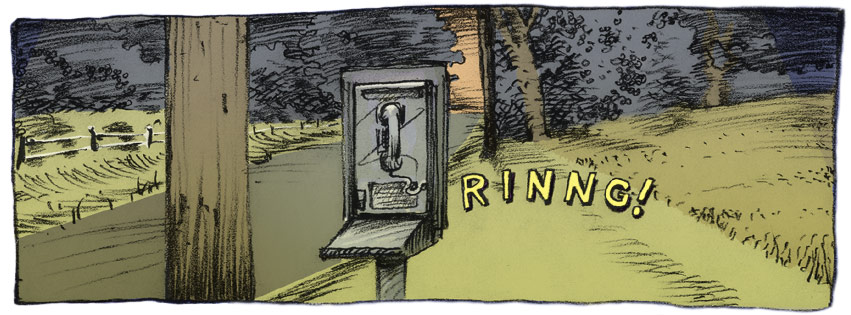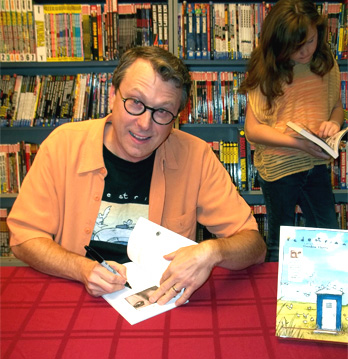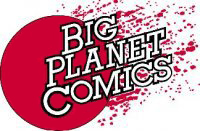| |||||||||||||||||||||||
| |||||||||||||||||||||||
| |||||||||||||||||||||||
| |||||||||||||||||||||||
Friday, October 12, 2012
Big Planet Comics Orbit Newsletter - 12 October 2012
Meet Two Local Cartoonists: Barb Fischer and Chris Impink of Studio Unseen
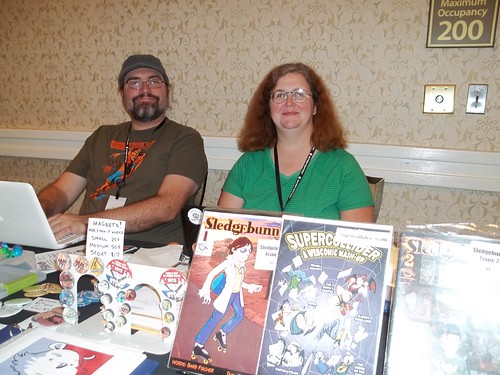
Barb Fischer and Chris Impink are webcomics creators who have worked on two long-running webcomics strips. On their Studio Unseen website, they describe their respective roles: "Barb Fischer does the writing as well as merchandise assembly and convention spotting; when not plotting out the nuts and bolts of Sledgebunny, she takes care of her nine-year-old son which gives her just enough time in the day to take one or two breaths before plunging back into the fray. At some point, she’s hoping to find the time to use up the boxes and boxes of fabric she owns. Chris Impink does the artwork and web design; he has been featured in Antarctic Press and did much of the graphic work forThe Babylon Project role-playing game. Additionally, his work has been featured at various conventions such as Katsucon, Technicon, and Rising Star. He is also mildly notorious for co-founding Katsucon, though his team of spin doctors has kept that under wraps for many years. In his rare moments of free time, Chris works with the crew from Super Art Fight, running the Wheel of Death and notching up wins on the championship belt." I met them at Intervention con this year and they agreed to answer my usual questions.
ComicsDC: What type of comic work or cartooning do you do?
 Barb: We have a graphic novel-style webcomic based in the world of roller derby called "Sledgebunny".
Barb: We have a graphic novel-style webcomic based in the world of roller derby called "Sledgebunny".
ComicsDC: How do you do it? Traditional pen and ink, computer or a combination?
Chris: The initial drawings are done in pen and ink, but the backgrounds and coloring are done in Photoshop.
ComicsDC: When (within a decade is fine) and where were you born?
Barb: 1970 in Roanoke, VA.
Chris: 1971 in Allentown, PA.
ComicsDC: Why are you in Washington now? What neighborhood or area do you live in?
Barb: When I moved here in 1999, it was because my then-husband had gotten a job up here. I currently live in Centreville.
Chris: I grew up in the area, but had moved to Blacksburg for a while. I came back when the job market wasn't great in southwest Virginia for artists. I currently live in Annandale.
ComicsDC: What is your training and/or education in cartooning?
Chris: While I have a degree in graphic design, my training in cartooning is largely self-taught.
ComicsDC: Who are your influences?
Barb: Monty Python, Terry Pratchett, the Marx Brothers, and Joss Whedon.
Chris: Miyazaki, Bill Watterson, Bryan Lee O'Malley
Barb: We'd be a bit more aggressive in marketing ourselves; we tend to be a bit quiet.
ComicsDC: What work are you best-known for?
 Barb: Fragile Gravity.
Barb: Fragile Gravity.
Chris: The work I've done with Super Art Fight.
ComicsDC: What work are you most proud of?
Barb: I've really enjoyed the work I've done on the new comic.
ComicsDC: What would you like to do or work on in the future?
Barb: Animation would be nice; there's also some short stories I've got on a back burner.
Chris: To revisit "The Vince Posthumous Files", which was a story-within-a-story in our last comic.
ComicsDC: What do you do when you're in a rut or have writer's block?
Chris: Minecraft.
ComicsDC: What do you think will be the future of your field?
Chris: Content delivery is being changed so much by tablets and smartphones that it's difficult to predict, but clearly comics will drift further away from traditional forms.
ComicsDC: What local cons do you attend ? The Small Press Expo, Intervention, or others? Any comments about attending them?
Barb: Intervention, Katsucon, Otakon, Anime USA, Balticon -- and that's just the ones in the DC metro area. We're very lucky that there are so many choices for fans here.
ComicsDC: . What's your favorite thing about DC?
Barb: The fact that there's so much to try out and do at almost any time of the year.
ComicsDC: Least favorite?
Both: The traffic.
ComicsDC: What monument or museum do like to take visitors to?
Both: The Udvar-Hazy Air & Space Museum.
ComicsDC: How about a favorite local restaurant?
Barb: Korshi.
Chris: Jaleo.
ComicsDC: Do you have a website or blog?
Barb: Our webcomic can be found at http://www.sledgebunny.com; we're also there on Facebook and Twitter.
Keeping up with Cyborg Richard Thompson's treatment part 3
Nick Galifianakis @ 11:59
Here's a cartoon Richard drew while people were poking his brain with a stick. We'll get a better scan of it soon--this was taken with a cellphone and is pretty blurry.
Keeping up with Cyborg Richard Thompson's treatment part 2
Nick Galifianakis @ 11:25
Another Cartoonist Brain Update:
Surgery started at 9:35. Richard is conscious (yoicks!) and doing great; they're testing as they go, and everything is good so far. They are about to start on the second hemisphere. The next update will probably include comments from the surgeon.
For those of you that have not had this kind of brain surgery: Richard is having a chip implanted in his brain in hopes of greatly alleviating his Parkinson's symptoms. Because everyone is different, his brain must be "listened to" and monitored while they search for just the right spot for maximum impact.
More later...
Surgery started at 9:35. Richard is conscious (yoicks!) and doing great; they're testing as they go, and everything is good so far. They are about to start on the second hemisphere. The next update will probably include comments from the surgeon.
For those of you that have not had this kind of brain surgery: Richard is having a chip implanted in his brain in hopes of greatly alleviating his Parkinson's symptoms. Because everyone is different, his brain must be "listened to" and monitored while they search for just the right spot for maximum impact.
More later...
and Amy, Richard's wife has reported now that he's out of surgery, and "Everything went great!"
Keeping up with Cyborg Richard Thompson's treatment
Cartoonist Nick Galifianakis is one of Richard's best and oldest friends and is with him today during the surgery. Nick's posting updates on Facebook about Richard's treatment today:
I try and keep this a "cartoons only" site. And since my pal, Richard Thompson, one of the giants in my field, is having brain surgery today, I'll stray a tiny bit to periodically update folks on his condition.
As of a few minutes ago:
Head shaved, halo attached, been through MRI, unconscious, surgeon about to scrub in.
The doctor agreed to let him draw a cartoon during surgery while they're testing out the placement of the electrodes. I told Richard to think of something worthy of posterity, as it will certainly be historic.
It will be posted on his blog ASAP, of course.
He has not yet put a hankie on his head and has told the brain specialist that his "brain hurts."
More later....
Fantom Comics' Comics Journeyman interviewed at Wash Examiner
THE 3-MINUTE INTERVIEW: The Comics Journeyman
Abby Hamblin
The Washington Examiner October 11, 2012
"I personally gave up reading regular books years ago." is the pull quote for me.
Fun fact: The last question on the website wasn't published in the paper.
Fun fact: The last question on the website wasn't published in the paper.
PR: PEDESTRIAN update
|
Thursday, October 11, 2012
Weldon on Sailor Twain
The Refreshingly Murky, Mysterious, Mist-Shrouded 'Sailor Twain'
by Glen Weldon
October 11, 2012
http://www.npr.org/blogs/monkeysee/2012/10/11/162629786/the-refreshingly-murky-mysterious-mist-shrouded-sailor-twain
Richard Thompson - Cyborg
Richard Thompson's a good friend of mine, and he's undergoing brain surgery tomorrow to control his Parkinson's disease. We at ComicsDC send our besh wishes.
OT: David Wasting Paper 2013 Young Cartoonist Contest
My friend David Paccia has started his David Wasting Paper 2013 Young Cartoonist Contest.
The contest is in honor of his mother (who didn't throw away his comics), and provides art supplies and how-to books for the winning teenage submission.
The contest is in honor of his mother (who didn't throw away his comics), and provides art supplies and how-to books for the winning teenage submission.
Rafer Roberts' Kickstarter campaign
Local bon vivant and cartoonist Rafer Roberts is Kickstarting his next collection of his Plastic Farm comic book. I'm in.
The Post on the National Gallery's Lichtenstein exhibit
Art Preview: "Roy Lichtenstein: A Retrospective" at the National Gallery of Art
The East Building's new show is a vibrant, thoughtful celebration of the artist's work.
Washington Post's After Hours blog October 11, 2012
Wednesday, October 10, 2012
The Post on tonight's Green Arrow tv series
'Arrow' review: A vigilante with good aim
By Hank Stuever,
Washington Post October 10 2012
http://www.washingtonpost.com/entertainment/tv/arrow-review-a-vigilante-with-good-aim/2012/09/13/6c973962-fdcf-11e1-a31e-804fccb658f9_story.html
Daumier and Oliphant at the Phillips
DAUMIER AND OLIPHANT, MASTERS OF POLITICAL SATIRE, ON VIEW AT THE PHILLIPS THROUGH INAUGURATION 2013
WHAT: Political Wits, 100 Years Apart: Daumier and Oliphant at the Phillips
Art thumbs its nose at politics in this election-inspired gallery, featuring works by Honoré Daumier (French, 1808–79) and Patrick Oliphant (Australian, b. 1935) from the museum's permanent collection.
A master of caricature and satire, Daumier so lampooned King Louis-Philippe that the artist was charged with sedition and imprisoned for six months in 1832. Pulitzer Prize-winning political cartoonist Oliphant—whose work has been exhibited at the National Portrait Gallery and the Library of Congress and published in the New Yorker, New York Times, and Washington Post—had a deep and longstanding admiration of Daumier. During a Daumier retrospective at the Phillips in 2000, Oliphant produced a lithograph inspired by the exhibition and proclaimed in his Washington Post review, "Monsieur Daumier, you certainly are a humbler."
A master of caricature and satire, Daumier so lampooned King Louis-Philippe that the artist was charged with sedition and imprisoned for six months in 1832. Pulitzer Prize-winning political cartoonist Oliphant—whose work has been exhibited at the National Portrait Gallery and the Library of Congress and published in the New Yorker, New York Times, and Washington Post—had a deep and longstanding admiration of Daumier. During a Daumier retrospective at the Phillips in 2000, Oliphant produced a lithograph inspired by the exhibition and proclaimed in his Washington Post review, "Monsieur Daumier, you certainly are a humbler."
WHEN: On view through the Presidential Inauguration, Jan. 20, 2013
COST: Weekends (Sept. 18–Oct. 5, 2012, and Jan. 7–20, 2013):
$10 for adults, $8 for visitors 62 and over and students, free for members and visitors 18 and under
Weekends (Oct. 6, 2012–Jan. 6, 2013):
$12 for adults, $10 for visitors 62 and over and students, free for members and visitors 18 and under
Weekdays: by donation
$10 for adults, $8 for visitors 62 and over and students, free for members and visitors 18 and under
Weekends (Oct. 6, 2012–Jan. 6, 2013):
$12 for adults, $10 for visitors 62 and over and students, free for members and visitors 18 and under
Weekdays: by donation
WHERE: The Phillips Collection
1600 21st St., NW. Metro: Dupont Circle (Q St. exit)
1600 21st St., NW. Metro: Dupont Circle (Q St. exit)
A flea market miscellany
Here's some of the oddball stuff I picked up last weekend:
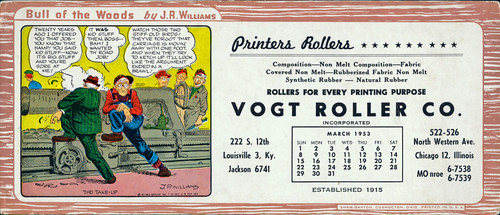
Bull of the Woods by J.R. Williams cartoon desk blotter / calendar from Vogt Roller Co, Chicago, IL in March 1953.
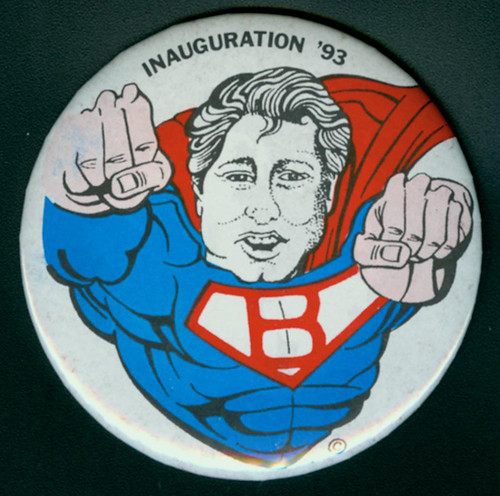
Bill Clinton superhero caricature on an Inauguration '93 button.

A counterfeit Bart Simpson saying "I belong to The Johns Hopkins Health Plan. Why In The Hell Don't You!" on an advertising button.
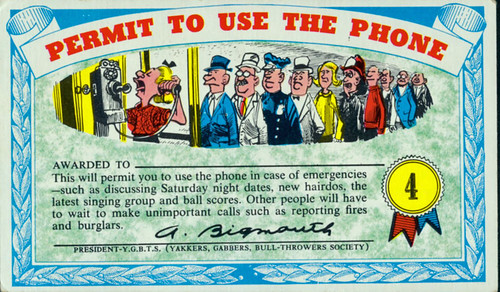
Nutty Awards #4 postcard by Jack Davis. Topps produced 30 of these in 1965.

Bull of the Woods by J.R. Williams cartoon desk blotter / calendar from Vogt Roller Co, Chicago, IL in March 1953.

Bill Clinton superhero caricature on an Inauguration '93 button.

A counterfeit Bart Simpson saying "I belong to The Johns Hopkins Health Plan. Why In The Hell Don't You!" on an advertising button.

Nutty Awards #4 postcard by Jack Davis. Topps produced 30 of these in 1965.
Frank Cho to draw Wolverine... and Shanna
Tuesday, October 09, 2012
Rethinking Rascally Roy (Lichtenstein, not Thomas)
Around the time Roy Lichtenstein starting painting his canvases influenced by comic book panels, editor Stan Lee was giving everyone at Marvel Comics a nickname to make the company appear more homey. Since Lichtenstein usually appropriated images from DC Comics, he probably wouldn't have qualified for one, but if he did, he probably should have gotten the 'Rascally' that eventually settled on writer Roy Thomas. Lichtenstein seems to have spent his entire career engaging with other art forms, appropriating them, making sport of them, but also in some odd way, respecting them.
 The National Gallery of Art is mounting a large career-spanning retrospective that begins with one of Lichtenstein's first comic-derived images - the Gallery's Look Mickey (1961). At the press preview, curators kept noting that the original image is from Donald Duck Lost and Found, a Little Golden Book from 1960, and not a comic book, but honestly that's a difference that makes no difference. Lichtenstein had come up with a hook, and a look, and together these let him break into the big time. To our eyes, familiar with almost forty years of later works, Look Mickey looks crude. The dots that texture Mickey's head and Donald's eyes are handpainted, and not made by forcing paint through a metal screen with a toothbrush as he would later turn to. The underlying pencil can be seen - something almost inconceivable in his work of just a few years later. Lichtenstein worked by doing a freehand drawing, projecting that piece onto a larger canvas and drawing it there, and then painting that. Examine this painting closely so you're prepared to see his technique evolve and tighten up as he finds his groove.
The National Gallery of Art is mounting a large career-spanning retrospective that begins with one of Lichtenstein's first comic-derived images - the Gallery's Look Mickey (1961). At the press preview, curators kept noting that the original image is from Donald Duck Lost and Found, a Little Golden Book from 1960, and not a comic book, but honestly that's a difference that makes no difference. Lichtenstein had come up with a hook, and a look, and together these let him break into the big time. To our eyes, familiar with almost forty years of later works, Look Mickey looks crude. The dots that texture Mickey's head and Donald's eyes are handpainted, and not made by forcing paint through a metal screen with a toothbrush as he would later turn to. The underlying pencil can be seen - something almost inconceivable in his work of just a few years later. Lichtenstein worked by doing a freehand drawing, projecting that piece onto a larger canvas and drawing it there, and then painting that. Examine this painting closely so you're prepared to see his technique evolve and tighten up as he finds his groove.

The Gallery owns 375 pieces of Lichtenstein's art -- one of the largest collections -- and this exhibit has 100 paintings, drawings and sculptures in it. They've borrowed from other museums and the show will travel to England and France after being here in DC. For comics and cartoon fans, after Look Mickey you can skip the rest of the Early Pop Art gallery, and go view the black & white drawing Alka Seltzer (1966) in the next room. To this reviewer, Jack Kirby's influence appears obvious -- and doesn't appear in the rest of the Black and White series. Kirby's Marvel Comics work had settled into its mature phase with the heavy black lines and over the top action that would typify his work. Lichtenstein's drawing of this banal subject produces a glass of Alka Seltzer that would look at home in the hands of Dr. Doom, if he ever stopped trying to conquer the world for a few minutes and looked after himself.
Instead of Marvel Comics, Lichtenstein turned to DC Comics for works in his Romance and War series. 1962's Masterpiece is the first in his Romance series, and he works in a joke about his new status as a darling of the art world. Contrast this work with Ohhh... Alright..., from 1964, and you can see his quoting of the comics medium becoming surer and cleaner, especially after he begins using his technique of painting through metal screens. Unfortunately, looking at the images here produces one of the main problems with Lichtenstein's comic-influenced art. When they are reproduced in a book (or blog) they become the same size as the comic they're taken from and this gives the viewer a false impression. These pieces are big, and the scaling-up while removing extraneous detail, and repositioning graphic elements gives them a... grandeur that insists that you see them in person.
Lichtenstein probably would have been a competent, if uninspiring comic book artist (think Don Heck) -- the original sketch for Ohhh... Alright... is in the exhibit and shows he could have done that, but the path he chose was probably better for all concerned. Bart Beaty's Comics Versus Art (University of Toronto Press, 2012) has a good chapter about the angst that Lichtenstein's work inspires in comic book readers - an angst I share. Lichtenstein was working from then-current comic books like Girls' Romances and Secret Hearts, and titling his works with an attribution such as Whaam! (after Novick) or Whaam! ( All American Men of War #89) rather than simply Whaam! would have been a gesture of respect to other artists who, although working as commercial illustrators in comic books, still considered what they were doing to be art.
 His decision not to do this continues to lead to headlines such as 2011's Connecting the Dots Between the Record $43 Million Lichtenstein and the $431 Comic Strip It Was Copied From, and articles that start "Imagine you drew a comic book for a nominal fee and a world-famous artist recreated in paint a panel from that work and sold it for millions of dollars without you receiving any credit or royalties." Deconstructing Roy Lichtenstein is an entire website devoted to tracking the original comic panels that Lichtenstein repurposed / appropriated for his paintings.
His decision not to do this continues to lead to headlines such as 2011's Connecting the Dots Between the Record $43 Million Lichtenstein and the $431 Comic Strip It Was Copied From, and articles that start "Imagine you drew a comic book for a nominal fee and a world-famous artist recreated in paint a panel from that work and sold it for millions of dollars without you receiving any credit or royalties." Deconstructing Roy Lichtenstein is an entire website devoted to tracking the original comic panels that Lichtenstein repurposed / appropriated for his paintings.
His Brushstrokes series began with Brushstrokes (1965), which the exhibit explains came from "The Painting," Strange Suspense Stories #72 (Charlton Comics, October 1964) -- the NGA reproduces the panel, but neglects to mention that the original artwork is by Dick Giordano. This was among his last of this type of work. Instead he began painting large fake brushstrokes over his now trademark dots, or painting the explosions without any intervening war comic scene. The exhibit wall text for Whaam! suggests a reason, quoting him reflecting "If you go through [comic books], you'll find that there are very few frames that... would be useful to you. Most of them are in transition, they don't really sum anything up and it's the ones that sum up the idea that I like best."
Lichenstein then moved completely away from the comics-influenced paintings to do similar paintings with other fine art as the subject, such as a faux woodcut of a Washington by Gilbert Stuart. Picasso and Cezanne and the Laocoon were Lichtensteinized. He painted faux architectural elements and faux mirrors, and did sculptures and paintings quoting art deco. He made landscapes out of dots. All of these can be seen in the show.
But in the 1990s and towards the end of his career, Lichtenstein returned to comic book art and looked back at the romance comic books he had painted from 30 years earlier -- this time, he just left off the clothing for his Nudes series. Without their captions or word balloons, and with a more radical use of dots, these paintings seem further removed from their sources than his earlier works.
 A lot has been written on Lichtenstein, and I'm obviously not an expert on his work, but I do think that his 1978 Self-Portrait, in which he depicts himself as a mirror hovering above an empty shirt -- while witty -- may very well also depict a deeper ambivalence about his career.
A lot has been written on Lichtenstein, and I'm obviously not an expert on his work, but I do think that his 1978 Self-Portrait, in which he depicts himself as a mirror hovering above an empty shirt -- while witty -- may very well also depict a deeper ambivalence about his career.
The exhibit Roy Lichtenstein: A Retrospective runs from October 14, 2012–January 13, 2013 at the National Gallery of Art. I can honestly recommend it to anyone interested in comic art who is willing to think about art, illustration, comics and where they all crash together. I would have preferred to see more of the original source material in the show -- only two comics panels are reproduced in the exhibit text -- and buying a 1960s DC romance comic or two wouldn't bust anyone's budget. An excellent catalog by curators James Rondeau and Sheena Wagstaff is available, and the Gallery has several events planned including ones at local restaurants Busboys and Poets and Ben's Chili Bowl.
UPDATE: Here's some pages that Lichtenstein used from Charlton and DC Comics (thanks to Prof. Witek)-
 The National Gallery of Art is mounting a large career-spanning retrospective that begins with one of Lichtenstein's first comic-derived images - the Gallery's Look Mickey (1961). At the press preview, curators kept noting that the original image is from Donald Duck Lost and Found, a Little Golden Book from 1960, and not a comic book, but honestly that's a difference that makes no difference. Lichtenstein had come up with a hook, and a look, and together these let him break into the big time. To our eyes, familiar with almost forty years of later works, Look Mickey looks crude. The dots that texture Mickey's head and Donald's eyes are handpainted, and not made by forcing paint through a metal screen with a toothbrush as he would later turn to. The underlying pencil can be seen - something almost inconceivable in his work of just a few years later. Lichtenstein worked by doing a freehand drawing, projecting that piece onto a larger canvas and drawing it there, and then painting that. Examine this painting closely so you're prepared to see his technique evolve and tighten up as he finds his groove.
The National Gallery of Art is mounting a large career-spanning retrospective that begins with one of Lichtenstein's first comic-derived images - the Gallery's Look Mickey (1961). At the press preview, curators kept noting that the original image is from Donald Duck Lost and Found, a Little Golden Book from 1960, and not a comic book, but honestly that's a difference that makes no difference. Lichtenstein had come up with a hook, and a look, and together these let him break into the big time. To our eyes, familiar with almost forty years of later works, Look Mickey looks crude. The dots that texture Mickey's head and Donald's eyes are handpainted, and not made by forcing paint through a metal screen with a toothbrush as he would later turn to. The underlying pencil can be seen - something almost inconceivable in his work of just a few years later. Lichtenstein worked by doing a freehand drawing, projecting that piece onto a larger canvas and drawing it there, and then painting that. Examine this painting closely so you're prepared to see his technique evolve and tighten up as he finds his groove.
The Gallery owns 375 pieces of Lichtenstein's art -- one of the largest collections -- and this exhibit has 100 paintings, drawings and sculptures in it. They've borrowed from other museums and the show will travel to England and France after being here in DC. For comics and cartoon fans, after Look Mickey you can skip the rest of the Early Pop Art gallery, and go view the black & white drawing Alka Seltzer (1966) in the next room. To this reviewer, Jack Kirby's influence appears obvious -- and doesn't appear in the rest of the Black and White series. Kirby's Marvel Comics work had settled into its mature phase with the heavy black lines and over the top action that would typify his work. Lichtenstein's drawing of this banal subject produces a glass of Alka Seltzer that would look at home in the hands of Dr. Doom, if he ever stopped trying to conquer the world for a few minutes and looked after himself.
Instead of Marvel Comics, Lichtenstein turned to DC Comics for works in his Romance and War series. 1962's Masterpiece is the first in his Romance series, and he works in a joke about his new status as a darling of the art world. Contrast this work with Ohhh... Alright..., from 1964, and you can see his quoting of the comics medium becoming surer and cleaner, especially after he begins using his technique of painting through metal screens. Unfortunately, looking at the images here produces one of the main problems with Lichtenstein's comic-influenced art. When they are reproduced in a book (or blog) they become the same size as the comic they're taken from and this gives the viewer a false impression. These pieces are big, and the scaling-up while removing extraneous detail, and repositioning graphic elements gives them a... grandeur that insists that you see them in person.
Lichtenstein probably would have been a competent, if uninspiring comic book artist (think Don Heck) -- the original sketch for Ohhh... Alright... is in the exhibit and shows he could have done that, but the path he chose was probably better for all concerned. Bart Beaty's Comics Versus Art (University of Toronto Press, 2012) has a good chapter about the angst that Lichtenstein's work inspires in comic book readers - an angst I share. Lichtenstein was working from then-current comic books like Girls' Romances and Secret Hearts, and titling his works with an attribution such as Whaam! (after Novick) or Whaam! ( All American Men of War #89) rather than simply Whaam! would have been a gesture of respect to other artists who, although working as commercial illustrators in comic books, still considered what they were doing to be art.
 His decision not to do this continues to lead to headlines such as 2011's Connecting the Dots Between the Record $43 Million Lichtenstein and the $431 Comic Strip It Was Copied From, and articles that start "Imagine you drew a comic book for a nominal fee and a world-famous artist recreated in paint a panel from that work and sold it for millions of dollars without you receiving any credit or royalties." Deconstructing Roy Lichtenstein is an entire website devoted to tracking the original comic panels that Lichtenstein repurposed / appropriated for his paintings.
His decision not to do this continues to lead to headlines such as 2011's Connecting the Dots Between the Record $43 Million Lichtenstein and the $431 Comic Strip It Was Copied From, and articles that start "Imagine you drew a comic book for a nominal fee and a world-famous artist recreated in paint a panel from that work and sold it for millions of dollars without you receiving any credit or royalties." Deconstructing Roy Lichtenstein is an entire website devoted to tracking the original comic panels that Lichtenstein repurposed / appropriated for his paintings.His Brushstrokes series began with Brushstrokes (1965), which the exhibit explains came from "The Painting," Strange Suspense Stories #72 (Charlton Comics, October 1964) -- the NGA reproduces the panel, but neglects to mention that the original artwork is by Dick Giordano. This was among his last of this type of work. Instead he began painting large fake brushstrokes over his now trademark dots, or painting the explosions without any intervening war comic scene. The exhibit wall text for Whaam! suggests a reason, quoting him reflecting "If you go through [comic books], you'll find that there are very few frames that... would be useful to you. Most of them are in transition, they don't really sum anything up and it's the ones that sum up the idea that I like best."
Lichenstein then moved completely away from the comics-influenced paintings to do similar paintings with other fine art as the subject, such as a faux woodcut of a Washington by Gilbert Stuart. Picasso and Cezanne and the Laocoon were Lichtensteinized. He painted faux architectural elements and faux mirrors, and did sculptures and paintings quoting art deco. He made landscapes out of dots. All of these can be seen in the show.
But in the 1990s and towards the end of his career, Lichtenstein returned to comic book art and looked back at the romance comic books he had painted from 30 years earlier -- this time, he just left off the clothing for his Nudes series. Without their captions or word balloons, and with a more radical use of dots, these paintings seem further removed from their sources than his earlier works.
 A lot has been written on Lichtenstein, and I'm obviously not an expert on his work, but I do think that his 1978 Self-Portrait, in which he depicts himself as a mirror hovering above an empty shirt -- while witty -- may very well also depict a deeper ambivalence about his career.
A lot has been written on Lichtenstein, and I'm obviously not an expert on his work, but I do think that his 1978 Self-Portrait, in which he depicts himself as a mirror hovering above an empty shirt -- while witty -- may very well also depict a deeper ambivalence about his career.The exhibit Roy Lichtenstein: A Retrospective runs from October 14, 2012–January 13, 2013 at the National Gallery of Art. I can honestly recommend it to anyone interested in comic art who is willing to think about art, illustration, comics and where they all crash together. I would have preferred to see more of the original source material in the show -- only two comics panels are reproduced in the exhibit text -- and buying a 1960s DC romance comic or two wouldn't bust anyone's budget. An excellent catalog by curators James Rondeau and Sheena Wagstaff is available, and the Gallery has several events planned including ones at local restaurants Busboys and Poets and Ben's Chili Bowl.
UPDATE: Here's some pages that Lichtenstein used from Charlton and DC Comics (thanks to Prof. Witek)-
 |
STRANGE SUSPENSE STORIES #72 p. 25 |
 |
| Secret Hearts #83, Nov. 1962 |
 |
| All-American Men of War #90 |
 |
| All-American Men of War #89 |
Monday, October 08, 2012
Letterhack and DC comics writer Irene Vartanoff interview from 2010
Irene used to live around here, and talks about writing to the Washington Star in this interview. Her sister Ellen is still in town.
Stroud, Brian D. 2010.
Irene Vartanoff Interview.
Silver Age Sage (May):
http://www.wtv-zone.com/silverager/interviews/vartanoff.shtml
Stroud, Brian D. 2010.
Irene Vartanoff Interview.
Silver Age Sage (May):
http://www.wtv-zone.com/silverager/interviews/vartanoff.shtml
Subscribe to:
Comments (Atom)


 As our astute readers noticed, I messed up the link to our SPX Special podcast, plus we took last week off, so now you get three podcasts all at once! Enjoy!
As our astute readers noticed, I messed up the link to our SPX Special podcast, plus we took last week off, so now you get three podcasts all at once! Enjoy! The gang behind the smash hit anthology Trickster is back with another great anthology all about the history of Washington, D.C.! Many of the writers and artists of District Comics: An Unconventional History of Washington D.C. will be appearing at both our Washington DC store on Saturday, October 27.
The gang behind the smash hit anthology Trickster is back with another great anthology all about the history of Washington, D.C.! Many of the writers and artists of District Comics: An Unconventional History of Washington D.C. will be appearing at both our Washington DC store on Saturday, October 27.












